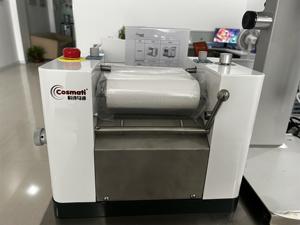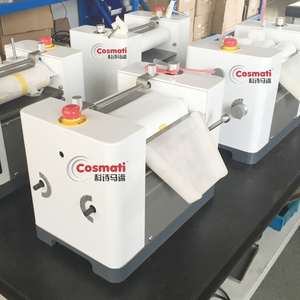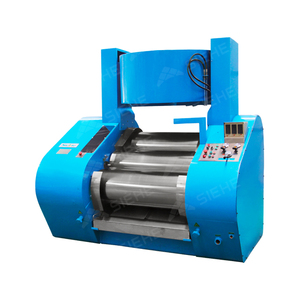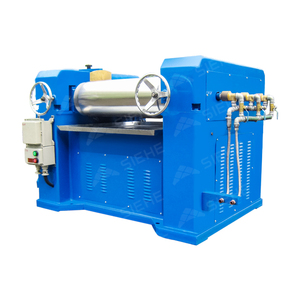
All categories
Featured selections
Trade Assurance
Buyer Central
Help Center
Get the app
Become a supplier

(821 products available)








































Roller mills, especially in the paint and coating industry, are essential for achieving the fine particle size and smooth texture necessary for high-quality paint products. Several types serve different roles, from laboratory testing to large-scale production.
These are small-scale mills used for testing and small-batch production. They enable manufacturers to test formulations and adjust components before going into full production. They have a small output, but they are crucial for quality control and product development.
These mills use three parallel rollers to grind and refine materials. They are often used for higher viscosity products like inks and certain heavy paints. The close spacing between the rollers ensures that even the finest particles are ground to a smooth texture.
In these, the grinding elements are often a combination of cylinders and a disc. It allows for a high output while maintaining a consistent particle size. These are mainly used for industrial applications.
These mills process a set amount of materials at once rather than a continuous flow. They offer more control over the milling process, making them useful when specific particle sizes are needed for particular paint formulations.
These are another popular choice. They use beads as the grinding media, which can achieve very fine particle sizes. These are commonly used in industries requiring extremely fine pigments, like automotive paints and industrial coatings.
In terms of durability and maintenance requirements, the bearings, grinding elements, and overall construction of the mills must be maintained properly to ensure consistent production.
These rollers are often made of steel alloy or are ceramic-coated for added durability. Steel alloy rollers are common in three-roller and bead mills. Meanwhile, ceramic coatings are often used in three-roller mills to prevent rust and reduce wear due to their ability to resist corrosion.
The grinding cylinders in horizontal roller mills are typically made of hardened steel or alloy steel. These materials are chosen for their toughness and ability to resist the grinding forces encountered during milling. Some designs also incorporate a ceramic or rubber lining to extend the lifespan of the cylinder in contact with aggressive pigments.
These disks can be made from hardened steel or other durable alloys, including cemented carbide. Cemented carbide offers exceptional hardness and lifespan, making it suitable for environments where wear from abrasive materials is a concern.
The housing or shell of a roller mill is generally constructed from mild or medium carbon steel. They are used predominantly for their structural strength. However, in high-wear areas, the steel may be hardened or have a protective layer of chrome or ceramic coating.
Bearing seats must be constructed with durable materials to support the heavy rollers and withstand continuous motion. These may include brass or bronze liners or high-quality steel with NTN, SKF, or TIMKEN. Proper lubrication is also essential, as it reduces friction and minimizes wear. Some mills feature a centralized lubrication system for easier maintenance.
The commercial value of these mills lies in their ability to produce high-quality paints more efficiently. As mentioned, they are crucial for achieving the desired texture, consistency, and particle size in paint.
Moreover, their primary commercial application is in the large-scale production of paints, coatings, and related products. The particle size and distribution directly impact the paint's viscosity, stability, and appearance. Thus, these mills ensure that the raw materials are processed to the correct specifications before being mixed into the final product.
Similar to paints, they also need finely milled pigments and other components for optimal performance. These mills break down the pigments to the desired particle size, which is critical for color strength and consistency. Thus, the ink industry benefits from using these mills to ensure effective color delivery without separating the pigment from the liquid carrier.
The mills are used for producing liquid paints and coatings like anti-corrosive, fire retardant, and other specialty coatings. These coatings are essential for protecting structures and equipment in demanding environments, such as chemical plants, oil rigs, and marine structures. The mills help grind materials like titanium dioxide to the necessary fineness for good coverage and durability in industrial applications.
Coatings in the automotive industry require precise control of particle size and distribution to ensure the paint flows properly during application and adheres correctly to the vehicle's surface. The mills handle such requirements as well as pigments for automotive paints to achieve the desired color, gloss, and long-term durability.
Completes the engineering and installation of mill systems for wood and furniture manufacturers requiring paints, stains, sealants, and other coatings. These industries rely on roller mills to ensure their products have the right consistency for easy application and a smooth finish.
The above industries use these mills to achieve the necessary particle sizes for different materials, impacting the final paint quality. Choosing one for specific operational requirements, quality standards, maintenance, and cost considerations is essential for optimal performance.
Consider the following recommendations when choosing one:
Refer to the certifications of quality standards achieved by the mills, for instance, an ISO certification. Their achievement is a guarantee that the materials of the mills and the final output paint of the mills adhere to specific quality standards, such as particle size distribution and material viscosity.
Examine the technical details of various roller mills to determine their grinding capacity, input power, and potential particle size range. The one that meets operational requirements should be selected to provide the desired consistency for different paint formulations.
Assess the requirements of the installation processes to factor in space and infrastructure needs. Consider how easy or complicated the installation of the preferred mill will be and whether such a distraction is necessarily worth it.
Analyze both direct and indirect costs related to the mortality of the mill, labor costs, energy wastage, etc., and several operational costs that may be incurred throughout the life of the mill, including the mortality of the equipment.
A finer particle size typically gives better paint quality, affecting the paint's texture, stability, and finish. The roller mill being selected should be capable of producing sufficient fine particles as desired in the paint compositions. The particle size distribution also needs to be checked, as a tight PSD is essential for high-quality, smooth paint.
Initially, determine the type of materials that will be used in the mill, such as pigments, fillers, and binders. A suitable mill should be compatible with the materials used for the paint composition to prevent chemical reactions or excessive wear and tear on the equipment.
A1: The material of the paint industry roller mill is crucial because it determines the mill's durability, which ultimately affects the quality of the final product. Specific materials are used for the parts of the mill to ensure that they can withstand prolonged contact with highly abrasive pigments.
A2: Any industry that requires the breakdown and refinement of particulate solids to achieve a specific size for paints, coatings, or other liquid materials will benefit from these mills. The automotive, construction, and wood industries were all mentioned above and are the ones that use these mills the most.
A3: Their design features speak for themselves. The close spacing between the rollers and the ability to apply very precise, controlled shear make them ideal for achieving the fine particle sizes and smooth textures required for high-quality paint formulations.